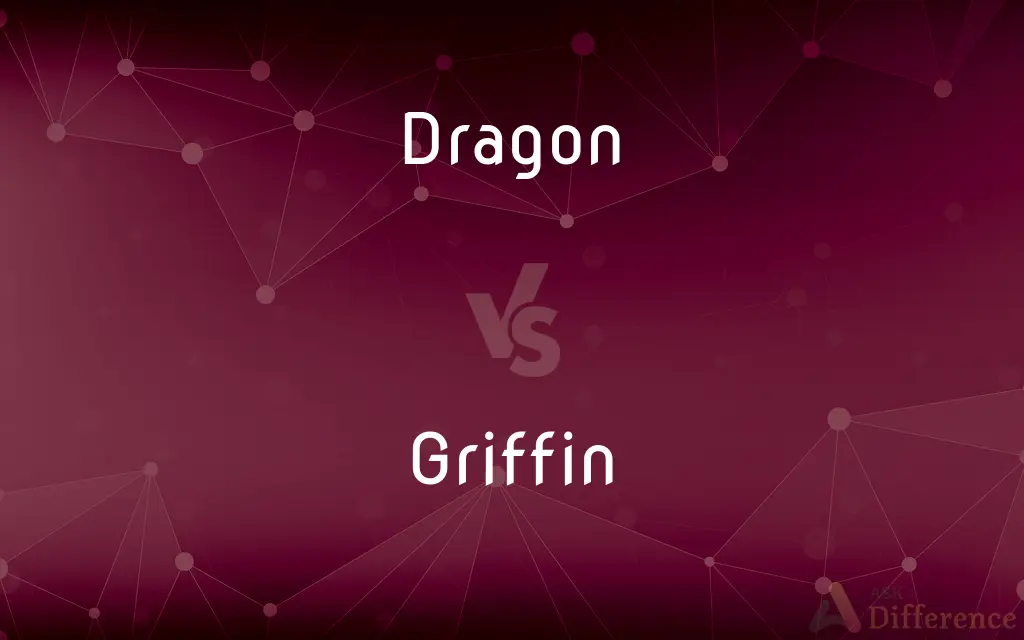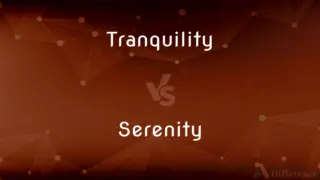Dragon vs. Griffin — What's the Difference?
By Urooj Arif & Fiza Rafique — Updated on April 2, 2024
A dragon is a mythical creature often depicted as a large, serpentine, and powerful being, capable of flying and breathing fire. A griffin, on the other hand, combines the body of a lion and the head and wings of an eagle, symbolizing strength and wisdom.

Difference Between Dragon and Griffin
Table of Contents
ADVERTISEMENT
Key Differences
Dragons are mythical creatures that have appeared in the folklore of many cultures worldwide. They are often depicted as large, powerful, and capable of breathing fire. On the other hand, griffins are mythical creatures with the body of a lion and the head, wings, and often the talons of an eagle. This combination of the king of the beasts and the king of the birds signifies both strength and wisdom, and griffins are often seen as guardians of treasures and other valuable objects.
While dragons can vary greatly in appearance, ranging from serpentine forms to lizard-like creatures with wings, griffins are more uniformly depicted with their lion-eagle hybrid form. This consistency in griffin imagery across cultures highlights a universal symbol of protection and vigilance, whereas dragons' varied appearances underscore their adaptability in representing everything from natural disasters to divine forces.
In terms of symbolic meaning, dragons often embody chaos, power, and sometimes fear, especially in Western cultures where they are frequently seen as adversaries to be overcome by heroes. In contrast, Eastern cultures often view dragons as benevolent beings, symbols of prosperity and good fortune. Griffins, however, consistently symbolize dual strength—combining terrestrial might (lion) and aerial supremacy (eagle)—and are universally recognized as symbols of divine power and protection, bridging the earth and sky.
The habitat and behavior of dragons in mythology also differ from those of griffins. Dragons are often associated with natural elements, such as fire or water, and may reside in caves, mountains, or bodies of water. Their ability to fly, breathe fire, or even control weather elements in some stories speaks to their role as formidable and often supernatural forces within their respective mythologies. Griffins, while also capable of flight, are typically depicted as guardians rather than destroyers, often associated with protecting precious metals or priceless treasures in their nests, which are located in remote or hard-to-reach places.
The cultural significance of dragons and griffins also varies. Dragons play central roles in the myths and legends of many cultures, from the dragons of European heraldry and folklore to the benevolent and wise dragons of East Asian cultures. Griffins, while perhaps less widespread in their cultural significance, were especially prominent in ancient Greek and Middle Eastern mythology, symbolizing divine protection and serving as emblems on shields and crests, indicating their role as protectors.
ADVERTISEMENT
Comparison Chart
Physical Appearance
Varies widely; typically serpentine or reptilian, with wings.
Body of a lion, head and wings of an eagle.
Symbolism
Power, wisdom, chaos, or malevolence; varies by culture.
Strength, wisdom, protection, divine power.
Cultural Origin
Global; prevalent in both Western and Eastern mythologies.
Ancient Greece, Middle East, and spread to Europe.
Role in Myths
Can be benevolent or malevolent; often a powerful force or adversary.
Guardians of treasures and symbols of divine protection.
Powers/Abilities
Flight, fire-breathing, control over natural elements (varies).
Flight, strength, and keen vision; guardian role.
Compare with Definitions
Dragon
Featured in many myths as a creature to be revered or battled.
The knight set out on his quest to slay the dragon and rescue the kingdom.
Griffin
Guardian of treasures and valuable objects.
Legends tell of griffins guarding gold mines in the mountains.
Dragon
A mythical creature often seen as a large, fearsome, and powerful being.
The dragon guarded the entrance to the magical realm.
Griffin
Symbolizes strength, wisdom, and divine protection.
The griffin is depicted on the family crest as a symbol of vigilance.
Dragon
Capable of breathing fire and flying.
The dragon unleashed a torrent of fire upon the invading army.
Griffin
Appears in various ancient cultures, symbolizing power and protection.
Ancient artifacts often feature griffins as protective symbols.
Dragon
Symbol of power and wisdom, varying from culture to culture.
In many Asian cultures, dragons are revered symbols of prosperity.
Griffin
A mythical creature with the body of a lion and the head and wings of an eagle.
The griffin stood guard over the ancient treasure.
Dragon
Associated with elements like fire or water.
The sea dragon rose from the depths during the storm.
Griffin
Combines the king of beasts and the king of birds.
The griffin represents the ultimate protector, combining the lion's strength with the eagle's vision.
Dragon
A dragon is a large, serpentine, legendary creature that appears in the folklore of many cultures worldwide. Beliefs about dragons vary considerably through regions, but dragons in western cultures since the High Middle Ages have often been depicted as winged, horned, four-legged, and capable of breathing fire.
Griffin
The griffin, griffon, or gryphon (Ancient Greek: γρύψ, grū́ps; Classical Latin: grȳps or grȳpus; Late and Medieval Latin: gryphes, grypho etc.; Old French: griffon) is a legendary creature with the body, tail, and back legs of a lion; the head and wings of an eagle; and sometimes an eagle's talons as its front feet. Because the lion was traditionally considered the king of the beasts, and the eagle the king of the birds, by the Middle Ages, the griffin was thought to be an especially powerful and majestic creature.
Dragon
See Draco2.
Griffin
A fabulous beast with the head and wings of an eagle and the body of a lion.
Dragon
A mythical monster traditionally represented as a gigantic reptile having a long tail, sharp claws, scaly skin, and often wings.
Griffin
A mythical beast having the body of a lion and the wings and head of an eagle.
Dragon
Any of various lizards, such as the Komodo dragon or the flying lizard.
Griffin
A large vulture (Gyps fulvus) found in the mountainous parts of Southern Europe, North Africa, and Asia Minor, supposed to be the "eagle" of the Bible.
Dragon
A fiercely vigilant or intractable person.
Griffin
An English variety of apple.
Dragon
Something very formidable or dangerous.
Griffin
A person who has just arrived from Europe.
Dragon
(Archaic) A large snake or serpent.
Griffin
A cadet newly arrived in British India: half English, half Indian.
Dragon
A legendary serpentine or reptilian creature.
Griffin
A watchful guardian, especially a duenna in charge of a young woman.
Dragon
In Western mythology, a gigantic beast, typically reptilian with leathery bat-like wings, lion-like claws, scaly skin and a serpent-like body, often a monster with fiery breath.
Griffin
An Anglo-Indian name for a person just arrived from Europe.
Dragon
In Eastern mythology, a large, snake-like monster with the eyes of a hare, the horns of a stag and the claws of a tiger, usually beneficent.
Griffin
A fabulous monster, half lion and half eagle. It is often represented in Grecian and Roman works of art.
Dragon
An animal of various species that resemble a dragon in appearance:
Griffin
A representation of this creature as an heraldic charge.
Dragon
(obsolete) A very large snake; a python.
Griffin
A species of large vulture (Gyps fulvus) found in the mountainous parts of Southern Europe, North Africa, and Asia Minor; - called also gripe, and grype. It is supposed to be the "eagle" of the Bible. The bearded griffin is the lammergeir.
Dragon
Any of various agamid lizards of the genera Draco, Physignathus or Pogona.
Griffin
An English early apple.
Dragon
A Komodo dragon.
Griffin
Winged monster with an eagle-like head and body of a lion
Dragon
The constellation Draco.
Dragon
(pejorative) A fierce and unpleasant woman; a harridan.
She’s a bit of a dragon.
Dragon
The (historical) Chinese empire or the People's Republic of China.
Napoleon already warned of the awakening of the Dragon.
Dragon
(figuratively) Something very formidable or dangerous.
Dragon
A type of playing-tile (red dragon, green dragon, white dragon) in the game of mahjong.
Dragon
A luminous exhalation from marshy ground, seeming to move through the air like a winged serpent.
Dragon
A short musket hooked to a swivel attached to a soldier's belt; so called from a representation of a dragon's head at the muzzle.
Dragon
A background process similar to a daemon.
Dragon
A variety of carrier pigeon.
Dragon
(slang) A transvestite man, or more broadly a male-to-female transgender person.
Dragon
A fabulous animal, generally represented as a monstrous winged serpent or lizard, with a crested head and enormous claws, and regarded as very powerful and ferocious.
The dragons which appear in early paintings and sculptures are invariably representations of a winged crocodile.
Thou breakest the heads of the dragons in the waters.
Thou shalt tread upon the lion and adder; the young lion and the dragon shalt thou trample under feet.
He laid hold on the dragon, that old serpent, which is the Devil and Satan, and bound him a thousand years.
Dragon
A fierce, violent person, esp. a woman.
Dragon
A constellation of the northern hemisphere figured as a dragon; Draco.
Dragon
A luminous exhalation from marshy grounds, seeming to move through the air as a winged serpent.
Dragon
A short musket hooked to a swivel attached to a soldier's belt; - so called from a representation of a dragon's head at the muzzle.
Dragon
A small arboreal lizard of the genus Draco, of several species, found in the East Indies and Southern Asia. Five or six of the hind ribs, on each side, are prolonged and covered with weblike skin, forming a sort of wing. These prolongations aid them in making long leaps from tree to tree. Called also flying lizard.
Dragon
A variety of carrier pigeon.
Dragon
A fabulous winged creature, sometimes borne as a charge in a coat of arms.
Dragon
A creature of Teutonic mythology; usually represented as breathing fire and having a reptilian body and sometimes wings
Dragon
A fiercely vigilant and unpleasant woman
Dragon
A faint constellation twisting around the north celestial pole and lying between Ursa Major and Cepheus
Dragon
Any of several small tropical Asian lizards capable of gliding by spreading winglike membranes on each side of the body
Common Curiosities
What are the primary differences between dragons and griffins?
Dragons are often associated with power and destruction, capable of breathing fire, while griffins combine the attributes of lions and eagles, symbolizing strength and protection.
Do griffins appear in any modern symbolism?
Yes, griffins continue to appear in modern heraldry and symbols, often representing courage, protection, and strength.
Are dragons always depicted as antagonists?
No, in many Eastern cultures, dragons are revered as wise and benevolent beings, contrasting with their more adversarial depiction in some Western mythologies.
What do griffins symbolize?
Griffins symbolize strength, wisdom, and divine protection, often serving as guardians of treasures.
How do the habitats of dragons and griffins differ?
Dragons are often associated with caves or elemental realms (fire, water), while griffins are said to nest in high mountains or other remote areas to guard treasures.
Why are dragons featured more prominently in mythology than griffins?
Dragons have a more versatile role in myths, embodying various elements and principles across different cultures, which may contribute to their more prominent presence in global mythology.
What does a griffin's combination of eagle and lion characteristics signify?
The combination signifies a merger of the best qualities of the king of birds (wisdom, vision) and the king of beasts (strength, bravery).
How do dragons vary in different cultures?
In Western cultures, dragons are often seen as malevolent, whereas in Eastern traditions, they are viewed as benevolent symbols of prosperity and good luck.
Can both dragons and griffins fly?
Yes, both creatures are typically depicted with the ability to fly, though their physical appearances and other abilities differ significantly.
Were dragons and griffins believed to be real in ancient times?
In ancient times, both creatures were often considered real or were symbolic representations of real phenomena, fears, or desires.
Share Your Discovery

Previous Comparison
Stag vs. Elk
Next Comparison
Tranquility vs. SerenityAuthor Spotlight
Written by
Urooj ArifUrooj is a skilled content writer at Ask Difference, known for her exceptional ability to simplify complex topics into engaging and informative content. With a passion for research and a flair for clear, concise writing, she consistently delivers articles that resonate with our diverse audience.
Co-written by
Fiza RafiqueFiza Rafique is a skilled content writer at AskDifference.com, where she meticulously refines and enhances written pieces. Drawing from her vast editorial expertise, Fiza ensures clarity, accuracy, and precision in every article. Passionate about language, she continually seeks to elevate the quality of content for readers worldwide.














































